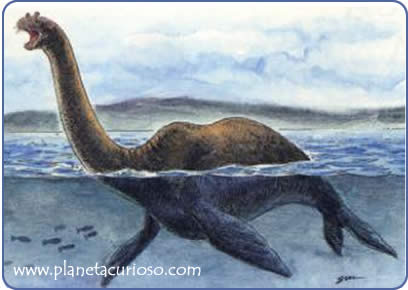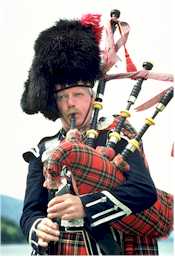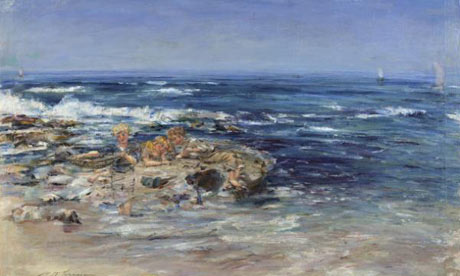In this essay I’m going to talk about a brief summary of characteristics of Scots such as his music, painting, literature, history, politics, economy, education, customs and traditions, myths and legends, foods and pastimes.
It must be said that the inhabitants of Scotland are descended from various racial groups, such as the Picts, Celts, Scandinavians, and to a lesser extent the Romans. Scotland is a both industrial and rural society. The Scots are divided themselves into highlanders (inhabitants of the Highlands), who believe that their ethnic affiliation is pure and maintain close links with the clans, and the lowlanders (inhabitants of the lowlands). There is a strong Scandinavian influence in the Orkney Islands and Shetland.
Music
It is a point clear and significant of the culture of this nation, which contains traditional and modern influences.
The instrument that most highlights of the land is the great Scottish bagpipes, wind instrument fed continuously by a reservoir of air in a bag and also the bagpipes are one of the most famous icons of Scotland, and the piping tradition is still going strong in the 21st century.
There are numerous gaiteras bands, consisting of bagpipes and various types of drums, showing Scottish music styles while creating new ones, has spread around the world.
Other instruments also traditional Scottish, although less characteristic are the harp, violin and accordion, and especially these last two are very prominent in Scottish country dance bands.
Currently, there are many successful bands of Scotland and its artists stand out in different styles such as Celtic folk, Traditional music and Folk music.
Art
Scottish painting is closely linked to the English artistic tradition, since many artists worked in London. Some were also great explorers, influenced the different European artistic movements. However, most remain unknown outside its borders. You can admire beautiful collections of Scottish painting in the national galleries in Edinburgh and the art museums in the country's major cities: Aberdeen, Glasgow, Perth, Dundee.
Literature
On the other hand Scottish literature is composed by authors born in that country and with more or less related topics must distinguish three literatures according its language employed as the Scottish-Gaelic literature. Scottish literature: and the Anglo-Scottish literature.
I can say that Scotland takes centuries to produce very important authors such as Robert Burns (1759–1759), Robert Louis Stevenson (1850-1894), Arthur Conan Doyle (1859-1930), Muriel Spark (1918-2006), Naomi Mitchison (1897-1999), Iain Banks (1954), Sorley Maclean (1911-1996) and Alasdair Gray (1934) among others after generation to generation and increasingly being marked a milestone in Scottish literature predominating in her creativity, innovation and experimentation by keeping literature alive.
 |
| Arthur Conan Doyle |
 |
| Robert Burns |
A brief history
 The troubled Scottish history covers a period of eight thousand years characterized by invasion and independence, war and religious excitement, intrigue and repression. But Scotland would also witness the blossoming of imagination and ingenuity in many areas of the field of human endeavour, which came to occupy a privileged position, not only within the United Kingdom, but in Europe and the rest of the world. The qualification of the 19th century Glasgow's second city of the British Empire is not a simple display. The country's history has left its mark on the soul of his people, as well as the landscape, and contributed largely to the impassioned pride with which the Scots today see themselves and their land.
The troubled Scottish history covers a period of eight thousand years characterized by invasion and independence, war and religious excitement, intrigue and repression. But Scotland would also witness the blossoming of imagination and ingenuity in many areas of the field of human endeavour, which came to occupy a privileged position, not only within the United Kingdom, but in Europe and the rest of the world. The qualification of the 19th century Glasgow's second city of the British Empire is not a simple display. The country's history has left its mark on the soul of his people, as well as the landscape, and contributed largely to the impassioned pride with which the Scots today see themselves and their land.
Politics
In the field of political Scotland is one of the constituent countries of the United Kingdom, as head of State to Queen Elizabeth II of the United Kingdom, since his coronation in 1952 and also Scotland has representation in the House of the Commons of the United Kingdom, with 59 representatives elected on the basis of Scottish constituencies.
In Scotland also the choice of the various ministers are nominated by the Scottish Parliament and are then approved by the Queen.
Economy
 Since 1987 the economic growth in Scotland has been exceeding the United Kingdom average, thanks to the new jobs generated by the industries that were created after the discovery of oil in the North Sea and to the success of Scotland in attracting high-tech industries.
Since 1987 the economic growth in Scotland has been exceeding the United Kingdom average, thanks to the new jobs generated by the industries that were created after the discovery of oil in the North Sea and to the success of Scotland in attracting high-tech industries.
The economy Nova Scotia is currently based in the services sector and the industrial sector , while still maintaining presence the primary sector .
Education
With regard to education Scottish children go to school until fourteen or sixteen, age in which can choose whether they decide or not to continue with their training. One of the main differences remaining between the Scottish education system and the followed by the rest of Great Britain is the first focuses on a wide range of subjects, while the second delves more into a few. Also Scotland has a significant range of universities as the University of Saint Andrews and is the oldest of that country or as St Andrews which is a relatively small city that has specialized in fields such as science and the arts offering pupils the possibility to live in a cosy and intellectual environment.
Customs and traditions
Scotland is a country that has many customs and traditions that are still shifting in generation after generation, and that I would say has been one of the key things in that country that despite the time which retains them respecting their origin.
How many times have heard names like: Mac Donald, Campbell, Mackintosh, Fergusson, Mac Lean, Montgomery, Mackenzie, Mac Gregor, Macbeth and such it is well known that they are typical Scottish surnames but sometimes don't know what that the offspring of one of the founders of a certain Clan (family).
Traditional Scottish society was organized into clans. The word clan derives in fact from the Scottish Gaelic clann, "child", which underlines the sense of family unity. Each Clan has a Tartan, official, and recorded in several versions. The kilt, as we know it, has been invented in the 700 by Thomas Rawlinson. The current kilt is used in particular way in official ceremonies which is made for up twenty-six feet fabric
Traditional Scottish society was organized into clans. The word clan derives in fact from the Scottish Gaelic clann, "child", which underlines the sense of family unity. Each Clan has a Tartan, official, and recorded in several versions. The kilt, as we know it, has been invented in the 700 by Thomas Rawlinson. The current kilt is used in particular way in official ceremonies which is made for up twenty-six feet fabric
According to tradition their placement was considered an art ritual, where the direction of the folds should be exact and perfect position.
You know that the Tartan gained popularity around the world during the 19th century because Queen Victoria fell in love with all things related to Scotland.
The following important dates for the Scottish
* Burns night: 25th January
* Tartan Day, April 6th
* Bannockburn Day: 24th June
* St Andrews Day: 30th November - St Andrews day is a holiday in Scotland and only a bank holiday
following the passing of the St Andrew's Day Bank Holiday (Scotland) Act 2007 which was passed bythe Scottish Parliament on 29th November 2006 and received Royal before on 15th January 2007.
* Burns night: 25th January
* Tartan Day, April 6th
* Bannockburn Day: 24th June
* St Andrews Day: 30th November - St Andrews day is a holiday in Scotland and only a bank holiday
following the passing of the St Andrew's Day Bank Holiday (Scotland) Act 2007 which was passed bythe Scottish Parliament on 29th November 2006 and received Royal before on 15th January 2007.
Myths and legends
Scotland as a country has many legends and myths in which appoints the most relevant:
Banshee or Banshea is a genius or fairy from Scottish and Irish mythology. There are various types, but they are mostly beneficial geniuses, who help humans and accompany the heaven to the souls of the children killed at birth or shortly after birth. If occur during sleep in the form of an old woman, heralding the near death of an important person.
The monster of Loch Ness animal legendary that lives in the depths of Loch Ness, a lake in the Highlands of northern Scotland. The common belief is that it is a female and the sightings date back to the year 565 ad when the Irish missionary St Columba claimed to have seen the Niseag (the Celtic name of Nessie) when he officiated the funeral of a man that the monster had bitten to death
Sir William Wallace (around 1270 - August 23, 1305), was a Scottish nobleman who led his country against English occupation and King Edward I of England in the wars for the independence of Scotland. In addition he was a man of convictions and principles which are valued to this day today.
Food
With regard to food Scotland has a reputation for having some of the best natural products in the world. Throughout Scotland and in any time of year, you can enjoy Festival of food and local produce markets. The variety of food is superb and includes meat, such as the "Aberdeen Angus" beef or lamb; hunting, such as deer, pheasant, grouse or Partridge; fish, like salmon or trout; and, of course, seafood, with some of the best oysters and mussels in the world.
One of the most traditional products of Scottish cuisine is Haggis, an economic and nutritious dish served with mashed potato and sweet potato. Never has what is done at this time that the person tastes the dish.
Scotland also has a range of very special soups, delicious desserts, exquisite cheeses, jams and breakfast and afternoon tea.
Pastimes
Scotland also has a variety of festivals and sports and pastimes such as: golf, football, rugby, tennis and many restaurants.
The inhabitants of Scotland have with more than 550 golf courses to play and there are a variety of fields for every level of golfer, each offers quality at a good price and a wide range of accommodation close to the field.
Taking as important tournaments such as Johnnie Walker Championship and The Open Championship, St Andrews.
Football is the most popular sport and there is a Scottish Premier League is divided into four divisions and in which teams of football in Scotland.
You can also enjoy Rugby due to is another popular sport and Scotland competes in the Six Nations Championship, which has won on numerous occasions in the past.
To play and practice tennis also has courts available at the Craiglockhart Tennis and Sports Centre.
Scotland also has many restaurants, cafes and pubs in large towns and cities which open throughout the day. Most of the pubs also serve coffee, snacks and meals; also the bars in hotels.
To finish this essay I can say that Scotland has been marked by several milestones throughout its history in various fields. Scotland is a country very rich in their culture that has been passed down from generation to generation likewise transferring their different traditions and customs, full of important myths and legends.
Scotland is a country that has many gastronomic and musical festivals attract a significant amount of tourists from around the world who are interested in knowing the peculiarities of the country.
Scotland is also a country that has music in his blood reflecting his feelings as a nation through the mystical bagpipe charm to any human being who listens to transporting them to medieval times.
References
Bruce M. Gittings. (1994-2002). GEO. Retrieved November 14th, 2011, from
References
Bruce M. Gittings. (1994-2002). GEO. Retrieved November 14th, 2011, from
Escocia, (2002-2011). Blog-escocia, http://blog-escocia.com/actualidad-de-escocia/fiestas-y-tradiciones-de-escocia
Escocia. (2011). Blog-escocia. Retrieved November 14th, 2011, from, http://blog-escocia.com/actualidad-de-escocia/deportes-en-escocia
Scotland, (2002-2011). Visitscotland, http://www.visitscotland.com/guide/scotland-factfile/arts-culture/music/
Scotland, (2002-2011). Visitscotland, http://www.visitscotland.com/guide/scotland-factfile/scottish-icons/the-kilt
Scotland, (2002-2011). Visitscotland, http://www.visitscotland.com/guide/scotland-factfile/scottish-icons/tartan
Scotland, (2002-2011). Visitscotland, http://www.visitscotland.com/guide/scotland-factfile/scottish-icons/burns-supper
Scotland, (2002-2011). Visitscotland, http://www.visitscotland.com/guide/inspirational/features/very-scottish/hogmanay
Scotland, (2003). Marariley, http://www.marariley.net/celtic/scotland.htm
Scotland, (2010). Highland games, http://www.highlandgames.org.uk/
Scotland, (2011). Kevin-peter.hubpages, http://kevin-peter.hubpages.com/hub/Scottish-Traditions-and-Customs
Scotland, (2011).Scottish wedding, http://scottishwedding.visitscotland.com/scottishweddingtraditions
Scotland. (2002-2011). Visitscotland. Retrieved November 14th, 2011, from
Scotland. (2002-2011). Visitscotland. Retrieved November 14th, 2011, from http://international.visitscotland.com/es/scots/agenda/noviembre/consejos/





























